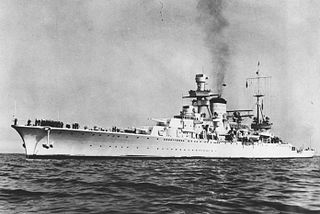
ARA Veinticinco de Mayo was a cruiser which served in the Argentine Navy. The English translation of the name is May 25, which is the date of Argentina's May Revolution in 1810.

ARA La Argentina was a light cruiser, designed for training naval cadets, built for the Argentine Navy. The ship was authorised in 1934, and the contract was put out to tender in 1935, being won by the British company Vickers-Armstrongs at a cost of 6 million pesos.
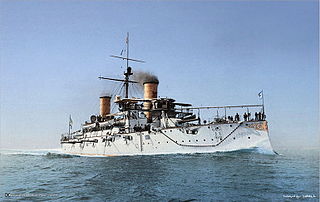
ARA General Belgrano was a Giuseppe Garibaldi-class armoured cruiser of the Argentine Navy. The ship was built in Italy, along with three sister ships also for Argentina. The vessel was the first to have been named after the Argentine founding father Manuel Belgrano (1770–1820). The ship was laid down in 1896 and served on the Argentine Navy until she was stricken on 8 May 1947.

ARA Garibaldi was one of four Giuseppe Garibaldi-class armored cruisers purchased by the Argentine Navy from Italy.

ARA San Martín was one of four Giuseppe Garibaldi-class armored cruisers purchased by the Argentine Navy from Italy.
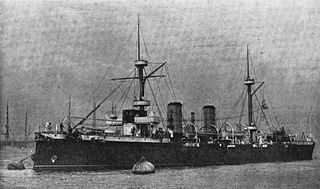
ARA Veinticinco de Mayo was a protected cruiser that served in the Argentine Navy between 1891 and 1921.

ARA Patagonia was an armoured cruiser that served in the Argentine Navy between 1886 and 1927.

ARA Libertad was a coastal defense ship that served in the Argentine Navy between 1892 and 1947, and with the Argentine Coast Guard as a pilot station ship from 1947 to 1968. It was the seventh Argentine naval ship with this name.
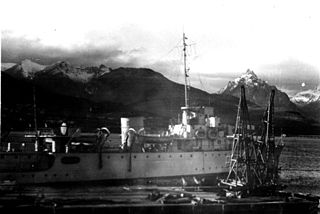
ARA King is a World War II-era Argentine Navy warship, originally classified as minelayer and later as patrol ship. The vessel is named after Juan King, an Argentine naval officer that served in the Cisplatine War. It is the third Argentine naval ship with this name.

ARA La Argentina was a steam corvette that served as a training ship with the Argentine Navy between 1884 and 1895, and in other roles until decommissioned in 1899.

ARA Paraná was a steam and sail corvette built in United Kingdom in 1873 which served as a gunboat with the Argentine Navy between 1874 and 1899. It was decommissioned in 1900, converted to a transport and renamed Piedrabuena.
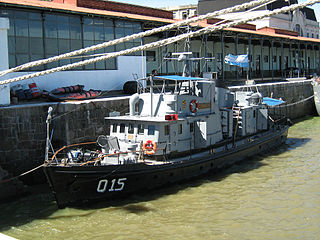
ARA Cormorán (Q-15) is a hydrographic survey boat of the Argentine Navy, built in the Río Santiago Shipyard and based in Buenos Aires. The vessel is named after the cormorant, a seabird that inhabits Argentina’s littoral, and is the fourth Argentine naval ship with this name.
ARA Azopardo was a steam transport of the Argentine Navy, built in the Stabilimento Tecnico Triestino and sold to Argentina in 1884. It was based, among others, in the port of Buenos Aires and later Ushuaia, and was decommissioned in 1922 after being sunk in an accident; it was refloated and sunk in 1924 as a target. The vessel was named after the Juan Bautista Azopardo, a Maltese privateer and officer of the Argentine Navy during the Independence and Cisplatine wars, and was the first Argentine naval ship with this name.

The Rosario-class gunboats were a class of two pre-World War I warships, designed and built in England in 1907–1909 as armoured riverine gunboats, to patrol the rivers Paraná and Uruguay. They were in service with the Argentine Navy from the late 1900s to the early 1950s. The lead ship of the class was named after Rosario, one of the major cities in Argentina.

ARA Canal Beagle (B-3) is a cargo ship in service with the Argentine Navy since 1978, capable of transporting bulk cargo, live cattle, and containers. She is the second ship in the Argentine Navy to bear the name of the Beagle Channel in the south of Tierra del Fuego.
ARA Luisito (Q-51) is a training ship of the Argentine Navy, in service since 1985 and based in Mar del Plata; where she is used to train students from Argentina’s National Fishing School. The vessel is the first Argentine naval ship with this name.

ARA Catamarca was the lead ship of her class of two destroyers built for the Argentine Navy during the 1910s in Germany. They were constructed there as Argentina lacked the industrial facilities needed to build them. Completed in 1912, the ship often served as a flotilla leader. She was modernized and rearmed during the mid-1920s. Catamarca spent 1932 in reserve, but was reactivated the following year. The ship conducted Neutrality Patrols during the Second World War before being transferred to the River Squadron in 1942. She was permanently reduced to reserve in 1947, discarded in 1956 and sold for scrap three years later.

ARA Jujuy was one of two Catamarca-class destroyers built for the Argentine Navy during the 1910s in Germany. They were constructed there as Argentina lacked the industrial facilities needed to build them. Completed in 1912, the ship often served as a training ship. She was modernized and rearmed during the late 1920s. Jujuy was assigned to the active fleet upon the completion of her modernization in 1931 before being transferred to the River Squadron in 1942. She was permanently reduced to reserve in 1947, discarded in 1956 and sold for scrap four years later.



















